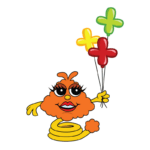At the beginning of kindergarten, we want students to think of the process of subtraction as “taking something away” or “minus.”
 For example, I have 8 M&Ms and someone eats 3, how many are left? But as kids start to progress higher in math, into the first part of 1st grade, we want to transition to an understanding of subtraction as the distance between two numbers.
For example, I have 8 M&Ms and someone eats 3, how many are left? But as kids start to progress higher in math, into the first part of 1st grade, we want to transition to an understanding of subtraction as the distance between two numbers.
This is especially important as students start to work with missing addends. For example, I want to have 13, but I only have 9, so how many more do I need to get to 13? This type of problem really uses the concept of the difference by giving you either minuend or the subtrahend to help you solve the equation. Using the counting up strategy or determining the distance between the two numbers can really help students understand what a subtraction problem is actually asking for, and when students miss this conceptual understanding of subtraction, it can have greater implications later on in more advanced math concepts.
Take my son, Connor, for example. The other night I was helping him with his 5th grade division homework. In division, the goal is to dwindle down the number based on how many groups of that number are in it, making sure to observe place value with the 100s, 10s or 1s. Connor’s problem was 243 divided by 9. He knew that 100 groups of 9 wouldn’t go into 243, so he put down a zero for the hundreds. He thought that at least 20 groups of 9 would go into 243, though, so he did 20 x 9, which is 180 and then was faced with a subtraction problem of 243-180. Since he’s been taught the traditional method of subtraction, he started in the 1s column with 3 – 0. Pretty easy! But when he got to the 10s, he was stopped by the 4 – 8.
For me, this was a no-brainer – how far was it from 180 to 240?? Those are friendly numbers! But I asked Connor that question and he said, “I don’t do it that way, I’ll just go next door and borrow.” He then went through a regrouping process to solve the problem. I was shocked! If he’d thought about those two numbers on a number line, it isn’t really all that complex! Starting at 180, it’s 20 more to get to 200, then another 40 to get to 240, for a total of 60. Even just looking at the difference between 18 and 24 would have been simple – 2 more to get to 20, then 4 more to get to 24 or a total of 6. But that concept of subtraction being the “difference between two numbers” wasn’t on his radar, even though it would have saved him that complicated regrouping process.

This situation tells me that, as kids get older, subtraction comes back to haunt them! And if they’re only learning T-Pops with his regrouping strategy (even though I love T-Pops!), it’s really just memorizing a procedure for a concept they don’t really understand.
Subtraction the Math Mights Way!
As we start to do number talks with subtraction and the Math Mights, I’m always blown away to hear students talk about how they go about solving subtraction problems and just how much they understand what they’re doing as they solve those problems. Their overall communicative reasoning is just profound!
One teacher told me about a boy in her class who was solving 110 – 82 using Springling. Springling likes to hop high and large distances, and she hates going by 1s because it flattens her fur. This boy was struggling with the distance from 82 to 90, and he told her, “Springling isn’t going to like me very much – her fur is going to be really flat because I needed to go by 1s.” Once he got from 82 to 90, he hopped to 100 and then 110, but he had internalized the strategy because he knew that there was probably a more efficient way to start hopping!
Those kinds of conversations are exactly what we want! It tell us that students understand the strategy and can apply it independently of a number talk, which means they’re ready for an activity like the Math Mights Showdown!
Math Mights Showdown – Subtraction Edition
Clearly, this is very similar to the Math Mights Showdown: Addition Edition from last week, just with subtraction problems! We also have two different characters specific to subtraction that are featured in this game.
Materials:
 Math Mights Subtraction dice. (2nd grade and up) The dice features our Math Might friends that star on the subtraction poster – Springling, Minni and Subbi, D.C., and T-Pops (Springling and Minni and Subbi are represented twice).
Math Mights Subtraction dice. (2nd grade and up) The dice features our Math Might friends that star on the subtraction poster – Springling, Minni and Subbi, D.C., and T-Pops (Springling and Minni and Subbi are represented twice).- Math Might Pencil Toppers:
- 1st grade: Springling
- 2nd and up: Springling, Minni and Subbi, D.C., and T-Pops
- Pencil cup
- Blank paper for each player
- Clear counters – 10 of one color per player.
- One game board. Choose one based on what you’re working on in your classroom with your students.
Place the game board in a clear plastic sleeve in the middle of the players, along with the pencil cup containing sharpened pencils topped with the Math Might Pencil Toppers.
Level 1
 Since, early on, we focus on counting up to find that distance between two numbers, Springling is the only Math Might strategy we use in 1st grade and our Level 1 game board reflects that. We can’t really use the dice for this level, since we’re only using Springling, but we’ve created a specialized game board for students who are working on a double-digit minus single digit problems so students can practice, using their Springling pencil topper! If they were doing 12 – 7, they can think of an open number line and show how, instead of hopping by 1s, they can start at 7 and hop 3 to the friendly number of 10, and then up 2 more to get to 12. 3 + 2 is 5.
Since, early on, we focus on counting up to find that distance between two numbers, Springling is the only Math Might strategy we use in 1st grade and our Level 1 game board reflects that. We can’t really use the dice for this level, since we’re only using Springling, but we’ve created a specialized game board for students who are working on a double-digit minus single digit problems so students can practice, using their Springling pencil topper! If they were doing 12 – 7, they can think of an open number line and show how, instead of hopping by 1s, they can start at 7 and hop 3 to the friendly number of 10, and then up 2 more to get to 12. 3 + 2 is 5.
Kids can put their counter on a problem, solve it with their Springling pencil, and then the next player goes until all the problems are taken. If a student gets an incorrect answer, they don’t get to put a counter on that problem and it remains available for others to solve. You also can use this game board as a whole class number talk.
Levels 2 and 3
The other subtraction game boards in the Math Mights Showdown: Subtraction Edition are for students to show off their math strategies with a variety of subtraction problems. One game board is 2-digit minus 2-digit problems. Students can roll the die, find out which strategy they are going to use, grab the corresponding Math Might pencil, and then select a problem from the board to solve using that strategy. Maybe they roll T-Pops, so they use the T-Pops pencil to apply the traditional strategy. Once the problem is solved correctly, the student keeps their counter on the problem.

If any other player feels the problem is incorrect, the next player has an opportunity to solve the problem using the same strategy. The problem continues around until it is solved correctly and the player who does so gets to put their counter on the problem. Then play goes back normal and the next player rolls the dice.
Accountability sheets are built right into the game because students can turn in their scratch paper and you can see what problems they worked through.
For level 2, students can just try to solve as many problems as possible before the board is filled up.
For level 3, students can try to get 4 in a row – vertically, horizontally, or diagonally. This level forces students to be more creative and flex their problem solving strategies because they might be forced to apply strategies to problems that might not be the most effective choice in order to block another player from getting 4 in a row.
I like having students roll the dice first and then pick their problem, but you could also have students select a problem first and then whatever strategy they roll is what they have to use with that problem. Either way forces students to think outside the box and really show off their knowledge of problem solving in a show down!
The rest of the game boards feature 2-digit minus 2-digit problems, decimal problems.
We left the last game board blank so you can fill in your own problems! You could use problems your students might have been struggling with in class or problems that lend themselves to a certain type of strategy that you want students to practice.
Math Mights Showdown is certainly a versatile tool! It could be a game, extra practice, a partner number talk, or even a whole class activity! We’d love to hear how you’re implementing the Math Mights Showdown!
If you haven’t gotten your Math Mights Pencil Toppers and Dice yet, add them to your cart today and get use the code MMLOVE to get 10% off (applies to the Math Mights Character Bundle only for the rest of the month of February)!





